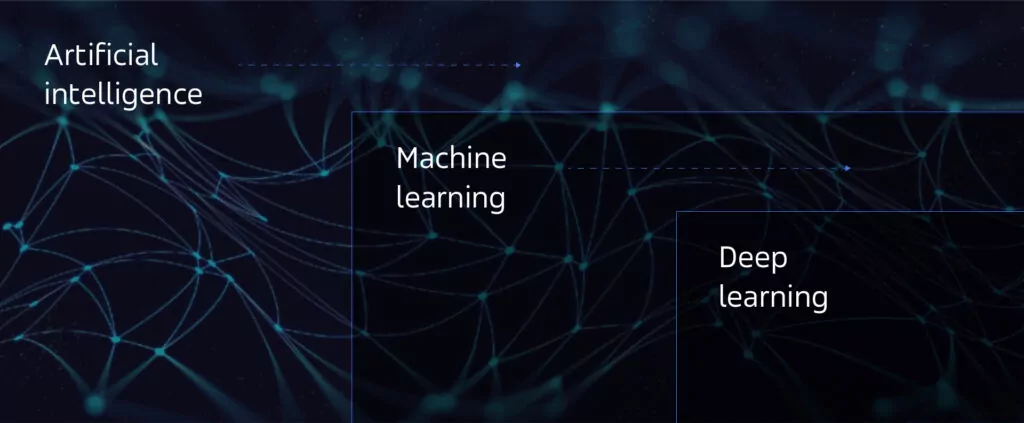Deep learning techniques have contributed to significant advancements in artificial intelligence and continue to drive innovation in various business domains by enabling machines to understand and process complex data in ways that were once thought to be exclusively within the realm of human intelligence.
Today’s article aims to navigate you through the broad sea of deep learning techniques and their real-world applications. Embark on this journey with us!
What is deep learning?
The deep learning definition can sometimes be unclear or mistaken, and it is frequently used interchangeably with artificial intelligence (AI) or machine learning (ML). Conversely, some individuals treat these three concepts as entirely distinct entities, which is, in fact, not accurate.
AI serves as an umbrella term encompassing both machine learning and deep learning. Therefore, deep learning exhibits all the characteristics of AI. Additionally, deep learning falls under the category of machine learning, making it the most specific and well-defined of the three terms, as presented below:

Deep learning meaning
Deep learning (DL) is a specialized subset of machine learning that centers on intricate models, typically constructed using deep neural networks, featuring numerous hidden layers. The most notable advantage of DL algorithms is their ability to eliminate the need for extensive feature engineering, as required in machine learning, as they learn features autonomously.
Instead, they automatically divide input data into multiple layers of abstraction and autonomously acquire essential features. However, this advantage comes at a cost – a significant amount of data is required to train a deep learning model effectively.
The essence and challenges of deep learning
The most important thing to remember is that to take advantage of deep learning, you need a significant amount of data. A small dataset, such as 2k positions, is insufficient to achieve meaningful results. Additionally, extensive resources, including computational power and time, are essential.
The second crucial aspect is that deep learning systems function as a black-boxes, which means they can be viewed solely based on their inputs and outputs without revealing their internal workings. In other words, their internal processes and model predictions cannot be explained in detail. This poses a challenge in companies where internal procedures dictate restrictions on the use of such systems.

Deep learning techniques and terms explained with examples
Deep learning is widely used in computer vision, speech recognition, and natural language processing. Essential deep learning techniques include:
Deep neural networks (DNNs)
Deep neural networks are a fundamental component within the field of deep learning in AI. DL focuses on training deep neural networks, among other techniques. DNNs are a class of neural networks with multiple layers of interconnected nodes or neurons. They are used to learn and represent complex patterns and relationships in data, making them suitable for tasks like image recognition, natural language processing, and more.
Deep neural networks (DNNs) play a pivotal role in our deep learning endeavors. An illustration of their application can be found in our flagship research and development project, in which we harnessed the power of deep learning algorithms for the precise counting and classification of microorganisms cultivated on Petri dishes.
Another use case is a system that automatically detects if employees wear masks in a car factory. To make it effective, we used deep neural networks, among others.
Convolutional neural networks (CNNs)
Being a type of DNN, CNNs are particularly effective in image analysis and computer vision tasks. They use convolutional layers to learn and detect features in the input data automatically. Convolutional neural networks have been pivotal in functions such as image classification, object detection, and facial recognition.
For example, we used the CNN technique to detect and count objects by estimating a density map. We trained the model on data with point-like annotations.
Generative adversarial networks (GANs)
GANs, a subgroup of CNNs, consist of two neural networks, a generator and a discriminator, that are trained simultaneously in a competitive setting. The generator generates data, while the discriminator tries to distinguish between real and synthetic data. GANs are used for generating realistic images, texts, and other data and are essential in the field of generative art and deepfake creation.
For example, utilizing the GAN technique, we have developed a visual identity for a clothing brand. This was the first corporate identity created live by the brand fans using AI.
Furthermore, we employed generative adversarial networks to generate synthetic images of bacteria and fungi in Petri dishes. Our objective was to produce samples that were missing from the original dataset.
Autoencoders
Autoencoders are unsupervised learning models that aim to learn compact representations of input data. Most often, they belong to the broader group of convolutional neural networks. They consist of an encoder that maps input data to a lower-dimensional latent space and a decoder that reconstructs the data from the latent space. Autoencoders are used in applications like image denoising, anomaly detection, and data compression.
For example, we utilized autoencoder models to develop an automated shrimp counting system within an industrial farm environment.
Reinforcement learning
Reinforcement learning is an independent type of algorithms. In RL an agent learns to make a sequence of decisions by interacting with an environment. The agent receives feedback in the form of rewards or punishments based on the actions it takes, and its goal is to learn a strategy that maximizes the cumulative reward over time. It has a variety of applications, including autonomous robotics, control tasks, and computer games.
You can read more about reinforcement learning in the context of the Unity Obstacle Tower Challenge in which we have participated. The task’s objective was to develop an agent capable of navigating the environment and achieving the highest attainable score within the time limit.
Self-supervised learning
This self-supervised network training technique leverages unlabeled data to train models by creating supervised learning tasks from the data itself. It has been used for various tasks, including feature learning, image and text representations, and pre-training models for downstream tasks.
As an example, we employ Wav2Vec 2.0, a deep learning model in automatic speech recognition. Its primary function is to convert spoken language into written text. It incorporates self-supervised learning techniques to enhance its performance.
A wrap-up
Today, deep learning is a dominant force in the field of artificial intelligence, powering a wide range of applications in computer vision, natural language processing, speech recognition, and more. It continues to advance rapidly, with researchers and organizations actively pushing the boundaries of what is possible with deep neural networks.
You can leverage our extensive expertise in deep learning projects to advance your business objectives. Get started with a one-hour, free-of-charge consultation to shape your product concept. Reach out to us today!





